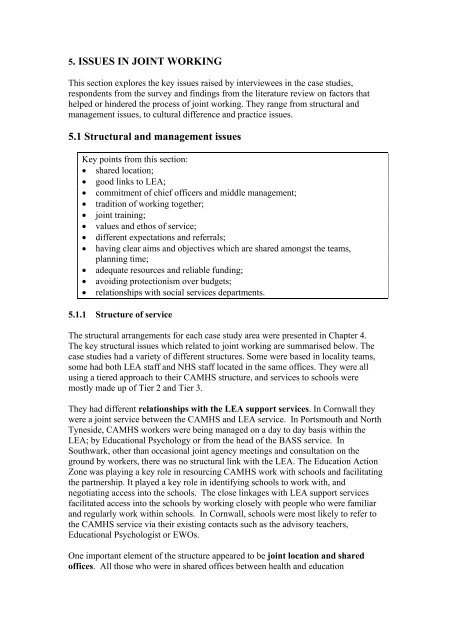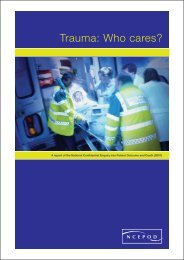(CAMHS) and Schools - London Health Programmes
(CAMHS) and Schools - London Health Programmes
(CAMHS) and Schools - London Health Programmes
You also want an ePaper? Increase the reach of your titles
YUMPU automatically turns print PDFs into web optimized ePapers that Google loves.
5. ISSUES IN JOINT WORKING<br />
This section explores the key issues raised by interviewees in the case studies,<br />
respondents from the survey <strong>and</strong> findings from the literature review on factors that<br />
helped or hindered the process of joint working. They range from structural <strong>and</strong><br />
management issues, to cultural difference <strong>and</strong> practice issues.<br />
5.1 Structural <strong>and</strong> management issues<br />
Key points from this section:<br />
• shared location;<br />
• good links to LEA;<br />
• commitment of chief officers <strong>and</strong> middle management;<br />
• tradition of working together;<br />
• joint training;<br />
• values <strong>and</strong> ethos of service;<br />
• different expectations <strong>and</strong> referrals;<br />
• having clear aims <strong>and</strong> objectives which are shared amongst the teams,<br />
planning time;<br />
• adequate resources <strong>and</strong> reliable funding;<br />
• avoiding protectionism over budgets;<br />
• relationships with social services departments.<br />
5.1.1 Structure of service<br />
The structural arrangements for each case study area were presented in Chapter 4.<br />
The key structural issues which related to joint working are summarised below. The<br />
case studies had a variety of different structures. Some were based in locality teams,<br />
some had both LEA staff <strong>and</strong> NHS staff located in the same offices. They were all<br />
using a tiered approach to their <strong>CAMHS</strong> structure, <strong>and</strong> services to schools were<br />
mostly made up of Tier 2 <strong>and</strong> Tier 3.<br />
They had different relationships with the LEA support services. In Cornwall they<br />
were a joint service between the <strong>CAMHS</strong> <strong>and</strong> LEA service. In Portsmouth <strong>and</strong> North<br />
Tyneside, <strong>CAMHS</strong> workers were being managed on a day to day basis within the<br />
LEA; by Educational Psychology or from the head of the BASS service. In<br />
Southwark, other than occasional joint agency meetings <strong>and</strong> consultation on the<br />
ground by workers, there was no structural link with the LEA. The Education Action<br />
Zone was playing a key role in resourcing <strong>CAMHS</strong> work with schools <strong>and</strong> facilitating<br />
the partnership. It played a key role in identifying schools to work with, <strong>and</strong><br />
negotiating access into the schools. The close linkages with LEA support services<br />
facilitated access into the schools by working closely with people who were familiar<br />
<strong>and</strong> regularly work within schools. In Cornwall, schools were most likely to refer to<br />
the <strong>CAMHS</strong> service via their existing contacts such as the advisory teachers,<br />
Educational Psychologist or EWOs.<br />
One important element of the structure appeared to be joint location <strong>and</strong> shared<br />
offices. All those who were in shared offices between health <strong>and</strong> education

















